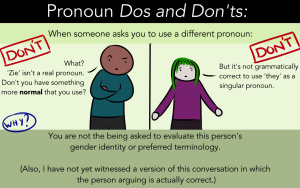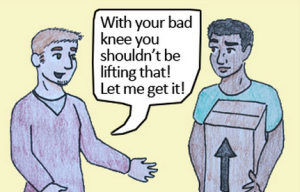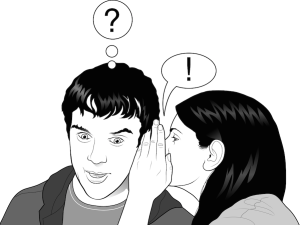
A person sitting on stone stairs, appearing happy as they listen to music from their bright yellow headphones.
This spring, I went on a wellness retreat of sorts. And during a “death meditation” exercise that involved stream-of-consciousness journaling, something unexpected came out.
I scrawled on the page, through tears, “I am not pink or blue; I am purple. I am not male or female; I am non-binary.”
This wasn’t the first time I’d had this thought.
In college, I began to describe myself as on the non-binary spectrum, but I was guilted into taking it back – because I didn’t perform “genderqueer” the way my friends wanted me to.
My discomfort didn’t come from my body, but instead, the gender norms imposed on me and a gender binary that I wanted no part in. But apparently, that made me an imposter.
So, during this meditation, when I decided I needed to be more open about being non-binary, I was really scared.
Scared that I was being appropriative. Scared that I was a liar.
I never experienced the distress of feeling like I had the wrong body. I just wholly disagreed with the idea of labeling people “men” and “women” based on the bodies they have.
This system wasn’t made for me, didn’t resonate with me – but people can be critical of those who treat their identities like a “political statement,” as if lacking dysphoria made my truth less sincere or valid.
I also faced resistance because I didn’t entirely want to give up calling myself a woman either. But that doesn’t mean I feel in my heart that woman adequately describes me.
It’s just that I’ve been socialized as a woman and I’m perceived as a woman, and for some people, what we’re socialized and perceived as can feel like a major part of who we are. For me, this experience makes me still feel connected to woman as an identifier.
So when I finally wrote my first article describing myself as non-binary, I felt so ashamed. There I was, assuming an identity I wasn’t sure I was prepared to live up to.
Afterward, whenever I wrote about misogyny, I stopped writing in the first person and started writing in the third person to distance myself, feeling no longer qualified to talk about what it’s like to be a woman.
When I did write about being a woman, I felt like a fraud. When I wrote about being non-binary, I also felt like a fraud. It was a confusing time.
There was also the fact that I identified as a woman to most people offline. I felt like I wasn’t a real non-binary person because I wasn’t proverbially “walking the walk.”
I yearned for a long time to ask other feminist writers how to handle this, but I was terrified of offending someone.
When I finally did post in a Facebook group about it, the comments didn’t – as I’d feared – accuse me of appropriating a marginalized identity from a privileged position. Instead, they supported me and told me I could talk about my gender however I needed to.
That’s when I realized that I wasn’t the one who was being oppressive. What was oppressive was the fact that I felt like I could only describe my gender identity in one static way. A gender “trinity” is similar to a gender binary in that way.
Now that I know it’s possible, I identify as both non-binary and as a woman. Here’s why that’s a totally legitimate identity.
1. Gender Can Change From Moment to Moment
Some people feel strongly that they have a fixed gender, but my gender feels more like a performance. When I do my nails, for example, I’m performing a certain American version of femininity. When I’m playing sports, I’m performing a particular version of masculinity (though these things aren’t inherently feminine or masculine).
When I’m writing about non-binary identity, I’m performing one form of that gender. When I wear androgynous clothes, I’m performing another form.
It’s not fair to expect everyone to have only one gender when gender means so many different things in different cultures and subcultures to different people.
Some people in my life don’t understand non-binary identity, and I’m not willing to do the (probably fruitless) emotional labor of trying to explain it to them and convince them it’s legitimate, so I choose to perform womanhood around them.
So, when I’m with people who know me as a woman, for me, they’re not misgendering me. I’m a woman with them.
I’m also a woman when I’m speaking about, say, being judged for making sacrifices for love or having thoughts related to internalized misogyny.
Not everyone who experiences these things is a woman. Sometimes, being perceived as a woman is enough. But for me, those two things are very intertwined, which I’ll explain in the next section.
2. Gender Is a Social Construct
Gender has never been something I felt deep within my heart. To me, it’s always felt like something assigned to me.
I never chose to have a gender. My parents gave me one because the hospital expected it of them, because the government expected it of them, and the chain of expectations goes back and back.
So, my gender is – in part – something that is ascribed to me. And that’s the part of me that feels like a woman.
The other non-binary part isn’t innate either, as many people believe genderqueer identity is, but it isn’t purely external either. It’s a decision I made because I don’t subscribe to the gender binary.
I consider both my genders to be constructs. The difference is that I played a more active role in constructing my non-binary identity.
My female identity, on the other hand, is the result of gender as a social construct. I cannot separate the gender I am treated and perceived as with the gender I am, because much of what I am is how I’m treated and perceived, especially since I don’t have an affiliation with a gender that feels innate or biological.
“Woman” can mean a lot of things, but when I use that label to describe myself, it doesn’t mean “someone with two X chromosomes” or “someone with a ‘female’ brain.”
It means I’ve faced oppression that makes me feel connected to the struggles many women in our society face, like sexual harassment and being assumed to be less intelligent.
Having these experiences doesn’t automatically make you a woman, but it personally contributes to my female identity.
So, even as I don’t feel that woman sums up how I feel on the inside, I can still be a woman in that way.
3. There Aren’t Any Rules
If anyone’s ever made you feel like you can only have one gender identity, ask yourself why you’re listening to them. This “rule” privileges cis people, and it’s one of the many ways trans and non-binary people get erased.
I was never directly told this, but it was something society enforced, both within and outside feminist and LGBTQIA+ communities.
Partially, it just came from seeing everyone else identify with only one gender. It also came from the narratives I heard about genderqueer people. Most were of trans people who felt they’d been born in the wrong body and experienced dysphoria from a young age.
One of my friends told me that if I’m not sure if I’m cis or not, I probably am, because actual genderqueer people don’t even have the privilege of asking that question.
Even people with good intentions will ask what pronoun – singular – they should refer to me as, encouraging the idea that I have to pick one.
This actually sets genderqueer people back by encouraging a narrow idea of who can be considered part of that group. It labels and stereotypes us as if we’re all the same.
It also medicalizes gender by encouraging the view that gender identity is something in your genes or your brain, when for many, it’s something ascribed to us by society or something we come up with in response to our life experiences or social and political beliefs.
In reality, non-binary people come in endless varieties, including those who don’t feel strongly and confidently about their gender identities.
Gender terminology is not one-word-fits-all. The pronoun or descriptor that works for one person may not work for another. So, using more than one label is sometimes necessary to tell the full, nuanced picture.
There’s no reason to restrict anyone’s identity other than to maintain a narrow, clean-cut definition of gender. So if that’s not your goal, you should be suspicious of any attempts, concrete or intangible, to tell you how you can and cannot identify.
As Sam Dylan Finch once told me, “Sometimes you’ve just got to Burger King it and have it your way.”
***
Some people experience their gender as one clear thing that doesn’t waver even when the way they’re treated does, and I don’t mean to take away from that.
But very often, experiences like mine get lost in favor of experiences like those. That’s because my experience challenges the societal notion of gender as something fixed, static, and black-and-white.
People who believe gender comes from the genes controlling hormones and brain development don’t want to hear about people whose gender is so socially constructed it’s context-dependent.
People who think everyone is male or female – or, at most, male, female, or non-binary – don’t want to hear from people who identify a totally different way.
People who think gender is one thing don’t want to hear from someone for whom it’s more than one thing.
People who think women are a certain way or men are a certain way or non-binary people are a certain way don’t want to hear from someone who “looks like” or “acts like” a certain gender but isn’t.
Because of these prescriptive notions of gender, voices like mine get erased and made to feel illegitimate.
But that doesn’t mean we’re a nonexistent or negligible population. In fact, I think a lot more people would identify with more than one gender if they knew they could. The only reason I didn’t is that I didn’t know it was allowed.
So, I’m telling you now, it’s allowed.
When it comes to your gender, nothing is disallowed, as long as you’re not hurting anyone. And the only way your gender identity can ever hurt anyone is if you try to impose it on somebody else. I’m no longer letting people do that to me.
[do_widget id=’text-101′]
Suzannah Weiss is a Contributing Writer for Everyday Feminism. She is a New York-based writer whose work has appeared in The Washington Post, Salon, Seventeen, Buzzfeed, The Huffington Post, Bustle, and more. She holds degrees in Gender and Sexuality Studies, Modern Culture and Media, and Cognitive Neuroscience from Brown University. You can follow her on Twitter @suzannahweiss.
Search our 3000+ articles!
Read our articles about:
Our online racial justice training
Used by hundreds of universities, non-profits, and businesses.
Click to learn more




















